Cultivation in an Alpine Region: Implications for Soil Bacteria
Abstract
1. Introduction
2. Materials and Methods
2.1. Study Area
2.2. Details of Selected Land Use Patterns
2.3. Soil Collection
2.4. Soil Physicochemical Analysis
2.5. Soil Bacterial Analysis
2.6. Statistical Analysis
3. Results
3.1. Soil Bacterial Taxonomic Classification and Composition
3.2. Soil Bacterial Alpha Diversity
3.3. Soil Bacterial Beta Diversity
3.4. Relationships between Soil Properties and Bacterial Variations
4. Discussion
5. Conclusions
Author Contributions
Funding
Data Availability Statement
Conflicts of Interest
References
- Ding, M.; Zhang, Y.; Sun, X.; Liu, L.; Wang, Z.; Bai, W. Spatiotemporal variation in alpine grassland phenology in the Qinghai-Tibetan Plateau from 1999 to 2009. Chin. Sci. Bull. 2013, 58, 396–405. [Google Scholar] [CrossRef]
- Wang, J.; Wang, X.; Liu, G.; Wang, G.; Zhang, C. Grazing-to-fencing conversion affects soil microbial composition, functional profiles by altering plant functional groups in a Tibetan alpine meadow. Appl. Soil Ecol. 2021, 166, 104008. [Google Scholar] [CrossRef]
- Yang, Y.; Li, H.; Zhang, L.; Zhu, J.; He, H.; Wei, Y.; Li, Y. Characteristics of soil water percolation and dissolved organic carbon leaching and their response to long-term fencing in an alpine meadow on the Tibetan plateau. Environ. Earth Sci. 2016, 75, 1471. [Google Scholar] [CrossRef]
- Yang, T.; Adams, J.; Shi, Y.; He, J.; Jing, X.; Chen, L.; Tedersoo, L.; Chu, H. Soil fungal diversity in natural grasslands of the Tibetan Plateau: Associations with plant diversity and productivity. New Phytol. 2017, 215, 756–765. [Google Scholar] [CrossRef] [PubMed]
- Huang, X.; Song, Z.; Groenigen, K.; Xu, Z.; Huang, B.; Zhang, Y.; Hang, X.; Tan, S.; Zhang, D.; Zhang, W. Grassland conversion along a climate gradient in northwest China: Implications for soil carbon and nutrients. Soil Use Manag. 2020, 36, 410–419. [Google Scholar] [CrossRef]
- Li, C.; Jong, R.; Schmid, B.; Wulf, H.; Schaepman, M. Changes in grassland cover and in its spatial heterogeneity indicate degradation on the Qinghai-Tibetan Plateau. Ecol. Indic. 2020, 119, 106641. [Google Scholar] [CrossRef]
- Huang, X.; Lu, X.; Zhou, G.; Shi, Y.; Zhang, D.; Zhang, W.; Bai, S. How land-use change affects soil respiration in an alpine agro-pastoral ecotone. Catena 2022, 214, 106291. [Google Scholar] [CrossRef]
- Bardgett, R.; Putten, W. Belowground biodiversity and ecosystem functioning. Nature 2014, 515, 505–511. [Google Scholar] [CrossRef]
- Bodelier, P. Interactions between nitrogenous fertilizers and methane cycling in wetland and upland soils. Curr. Opin. Environ. Sustain. 2011, 3, 379–388. [Google Scholar] [CrossRef]
- Delgado-Baquerizo, M.; Maestre, F.; Reich, P.; Jeffries, T.; Gaitan, J.; Encinar, D.; Berdugo, M.; Campbell, C.; Singh, B. Microbial diversity drives multifunctionality in terrestrial ecosystems. Nat. Commun. 2016, 7, 10541. [Google Scholar] [CrossRef]
- Chen, D.; Cheng, J.; Chu, P.; Bai, Y. Regional-scale patterns of soil microbes and nematodes across grasslands on the Mongolian plateau: Relationships with climate, soil, and plants. Ecography 2015, 38, 622–631. [Google Scholar] [CrossRef]
- Dai, H.; Zhang, H.; Li, Z.; Liu, K.; Zamanian, K. Tillage Practice Impacts on the Carbon Sequestration Potential of Topsoil Microbial Communities in an Agricultural Field. Agronomy 2021, 11, 60. [Google Scholar] [CrossRef]
- Le, H.; Rochelle-Newall, E.; Ribolzi, O.; Janeau, J.; Huon, S.; Latsachack, K.; Pommier, T. Land use strongly influences soil organic carbon and bacterial community export in runoff in tropical uplands. Land Degrad. Dev. 2020, 31, 118–132. [Google Scholar] [CrossRef]
- Lu, M.; Ren, Y.; Wang, S.; Tian, K.; Sun, X.; Peng, S. Contribution of soil variables to bacterial community composition following land use change in Napahai plateau wetlands. J. Environ. Manag. 2019, 246, 77–84. [Google Scholar] [CrossRef] [PubMed]
- Rodrigures, J.; Pellizari, V.; Mueller, R.; Baek, K.; Jesus, E.; Paula, F.; Mirza, B.; Hamaoui, G.; Tsai, S.; Feigl, B.; et al. Conversion of the Amazon rainforest to agriculture results in biotic homogenization of soil bacterial communities. Proc. Natl. Acad. Sci. USA 2013, 110, 988–993. [Google Scholar] [CrossRef] [PubMed]
- Sun, Y.; Luo, C.; Jiang, L.; Song, M.; Zhang, D.; Li, J.; Li, Y.; Ostle, N.; Zhang, G. Land-use changes alter soil bacterial composition and diversity in tropical forest soil in China. Sci. Total Environ. 2020, 712, 136526. [Google Scholar] [CrossRef]
- Viruel, E.; Fontana, C.; Puglisi, E.; Nasca, J.; Banegas, N.; Cocconcelli, P. Land-use change affects the diversity and functionality of soil bacterial communities in semi-arid Chaco region, Argentina. Appl. Soil Ecol. 2022, 172, 104362. [Google Scholar] [CrossRef]
- Li, Y.; Wang, S.; Jiang, L.; Zhang, L.; Cui, S.; Meng, F.; Wang, X.; Li, X.; Zhou, Y. Changes of soil microbial community under different degraded gradients of alpine meadow. Agric. Ecosyst. Environ. 2016, 222, 213–222. [Google Scholar] [CrossRef]
- Qi, X.; Wang, C.; He, T.; Ding, F.; Zhang, X.; An, L.; Xu, S. Bacterial community changes and their responses to nitrogen addition among diferent alpine grassland types at the eastern edge of Qinghai–Tibetan Plateau. Arch. Microbiol. 2021, 203, 5963–5974. [Google Scholar] [CrossRef]
- Yin, Y.; Wang, Y.; Li, S.; Liu, Y.; Zhao, W.; Ma, Y.; Bao, G. Soil microbial character response to plant community variation after grazing prohibition for 10 years in a Qinghai-Tibetan alpine meadow. Plant Soil. 2021, 458, 175–189. [Google Scholar] [CrossRef]
- He, Y.; Xu, M.; Qi, Y.; Dong, Y.; He, X.; Li, J.; Liu, X.; Sun, L. Differential Responses of Soil Microbial Community to Four-Decade Long Grazing and Cultivation in a Semi-Arid Grassland. Sustainability 2017, 9, 128. [Google Scholar] [CrossRef]
- Bai, Z.; Zheng, L.; Bai, Z.; Jia, A.; Wang, M. Long-term cultivation alter soil bacterial community in a forest-grassland transition zone. Front. Microbiol. 2022, 13, 1001781. [Google Scholar] [CrossRef] [PubMed]
- Tang, S.; Li, S.; Wang, Z.; Zhang, Y.; Wang, K. Effects of grassland converted to cropland on soil microbial biomass and community from agro-pastoral ecotone in Northern China. Grassl. Sci. 2022, 68, 36–43. [Google Scholar] [CrossRef]
- Bremner, J. Nitrogen-total. In Methods of Soil Analysis; Sparks, D.L., Ed.; SSSA: Madison, WI, USA, 1996; pp. 532–535. [Google Scholar]
- Mclean, E.O. Soil pH and Lime Requirement. In Methods of Soil Analysis; Page, A.L., Ed.; SSSA: Madison, WI, USA, 1982; pp. 199–224. [Google Scholar]
- Yang, F.; Wu, J.; Zhang, D.; Chen, Q.; Zhang, Q.; Cheng, X. Soil bacterial community composition and diversity in relation to edaphic properties and plant traits in grasslands of southern China. Appl. Soil Ecol. 2018, 128, 43–53. [Google Scholar] [CrossRef]
- Viruel, E.; Fontana, C.; Bassi, D.; Puglisi, E.; Radrizzani, A.; Martinez Calsina, L.; Banegas, N.; Cocconcelli, P. Silvopastoral systems in dry Chaco, Argentina: Impact on soil chemical parameters and bacterial communities. Soil Use Manag. 2020, 37, 866–878. [Google Scholar] [CrossRef]
- Sait, M.; Davis, K.; Janssen, P. Effect of pH on isolation and distribution of members of subdivision 1 of the phylum Acidobacteria occurring in soil. Appl. Environ. Microbiol. 2006, 72, 1852–1857. [Google Scholar] [CrossRef]
- Bukar, M.; Sodipo, O.; Dawkins, K.; Ramirez, R.; Kaldapa, J.; Tarfa, M.; Esiobu, N. Microbiomes of top and sub-layers of semi-arid soils in north-eastern Nigeria are rich in firmicutes and proteobacteria with surprisingly high diversity of rare species. Adv. Microbiol. 2019, 9, 1024–1118. [Google Scholar] [CrossRef]
- Cao, J.; Wang, H.; Holden, N.; Adamowski, J.; Biswas, A.; Zhang, X.; Feng, Q. Soil properties and microbiome of annual and perennial cultivated grasslands on the Qinghai–Tibetan Plateau. Land Degrad. Dev. 2021, 32, 5306–5321. [Google Scholar] [CrossRef]
- He, B.; Duan, X.; Rong, L.; Zhang, R.; Li, Y.; Lu, H. Land use controls soil bacterial diversity in the dry-hot valley region, Southern China. Arch. Agron. Soil Sci. 2020, 66, 694–705. [Google Scholar] [CrossRef]
- Cui, Y.; Dong, Y.; Liu, H.; Sun, Z. Short-term grazing exclusions reduced soil organic carbon but not bacterial diversity in the sagebrush desert, Northwest China. Glob. Ecol. Conserv. 2021, 31, e01872. [Google Scholar] [CrossRef]
- Zhang, C.; Liu, G.; Song, Z.; Wang, J.; Guo, L. Interactions of soil bacteria and fungi with plants during long-term grazing exclusion in semiarid grasslands. Soil Biol. Biochem. 2018, 124, 47–58. [Google Scholar] [CrossRef]
- Zhang, Y.; Gao, X.; Hao, X.; Alexander, T.; Shi, X.; Long, J.; Thomas, B. Heavy grazing over 64 years reduced soil bacterial diversity in the foothills of the Rocky Mountains, Canada. Appl. Soil Ecol. 2020, 147, 103361. [Google Scholar] [CrossRef]
- Zhou, X.; Wang, J.; Hao, Y.; Wang, Y. Intermediate grazing intensities by sheep increase soil bacterial diversities in an Inner Mongolian steppe. Biol. Fertil. Soils 2010, 46, 817–824. [Google Scholar] [CrossRef]
- Zhang, K.; Cheng, X.; Shu, X.; Liu, Y.; Zhang, Q. Linking soil bacterial and fungal communities to vegetation succession following agricultural abandonment. Plant Soil 2018, 431, 19–36. [Google Scholar] [CrossRef]
- Zhao, X.; Zhang, S.; Niu, K. Relationships between soil fungal diversity, plant community functional traits, and soil attributes in Tibetan alpine meadows. Chin. J. Appl. Environ. Biol. 2020, 26, 1–9. (In Chinese) [Google Scholar]
- Eisenhauer, N.; Schulz, W.; Scheu, S.; Jousset, A.; Pfrender, M. Niche dimensionality links biodiversity and invisibility of microbial communities. Funct. Ecol. 2013, 27, 282–288. [Google Scholar] [CrossRef]
- Foster, K.; Bell, T. Competition, not cooperation, dominates interactions among culturable microbial species. Curr. Biol. 2012, 22, 1845–1850. [Google Scholar] [CrossRef]
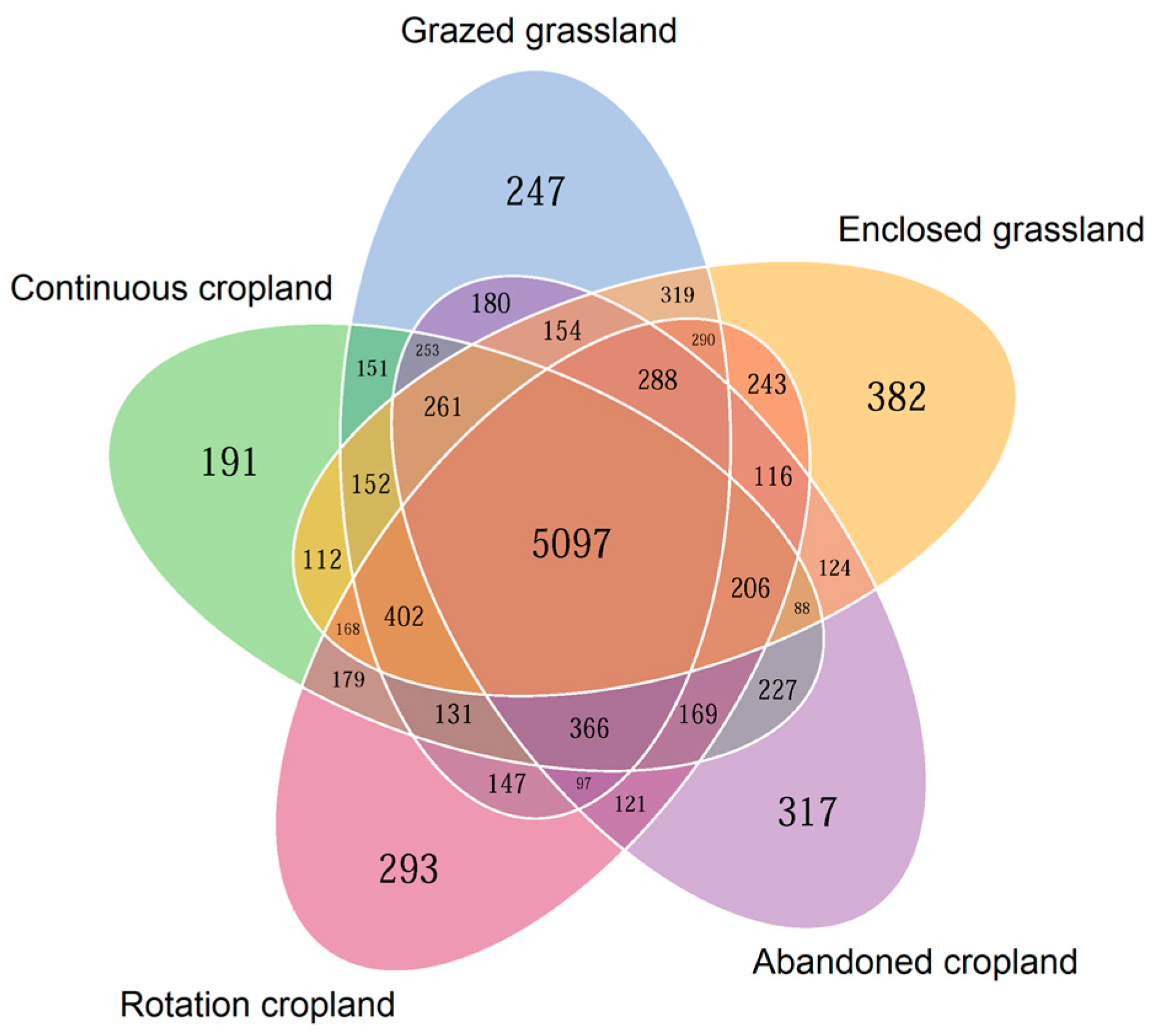

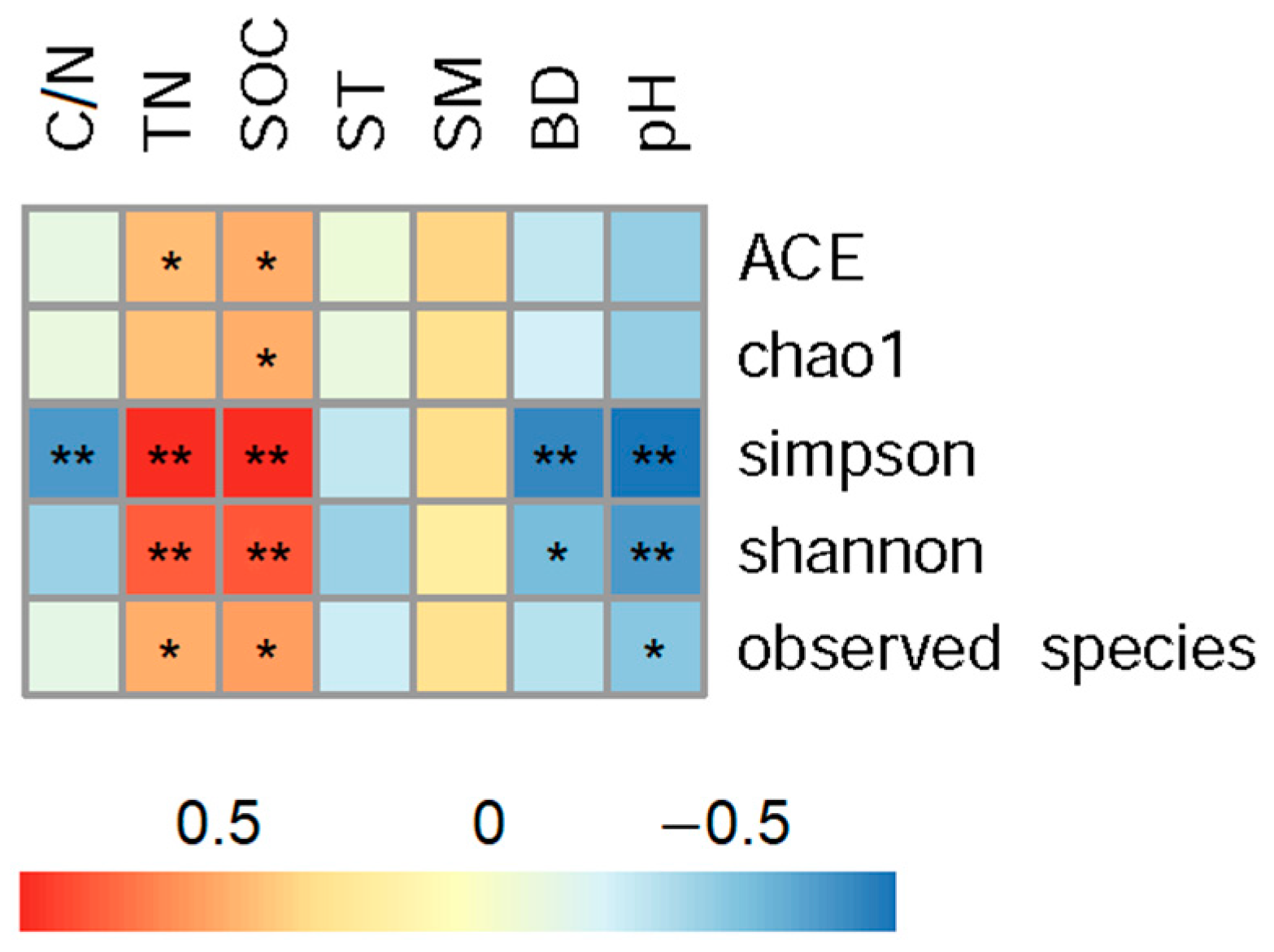
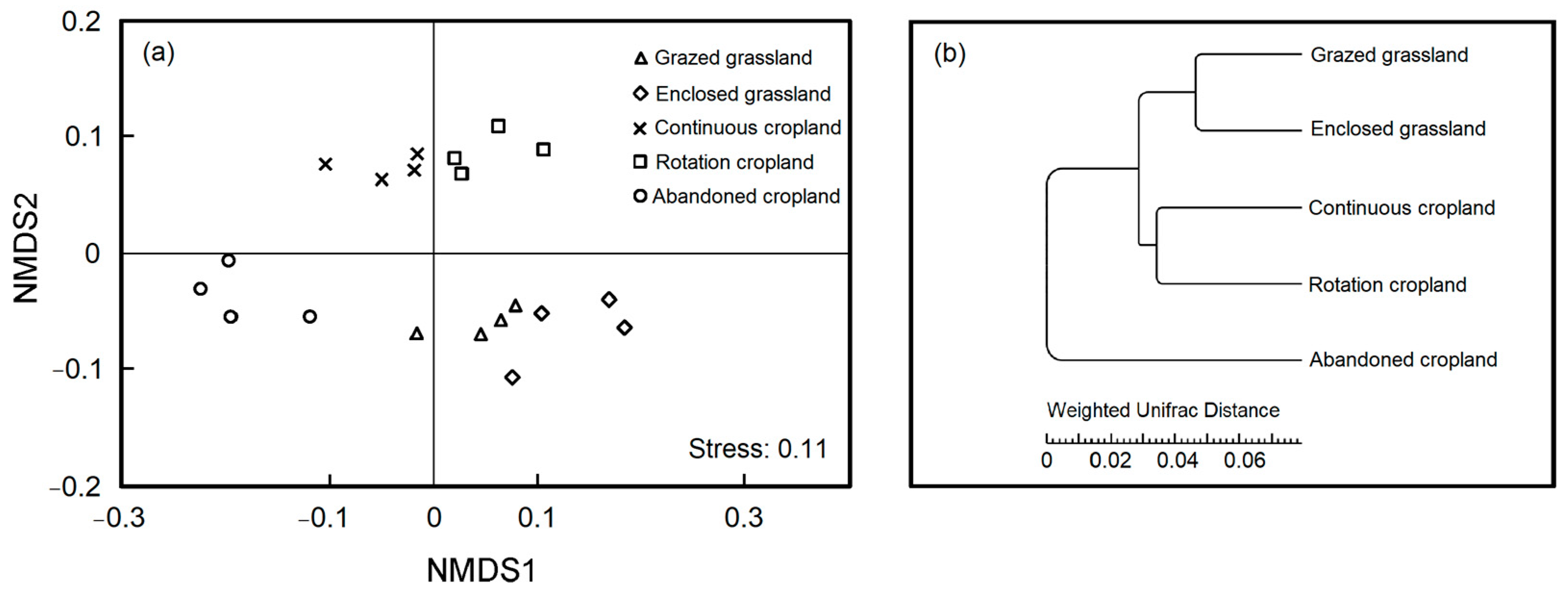
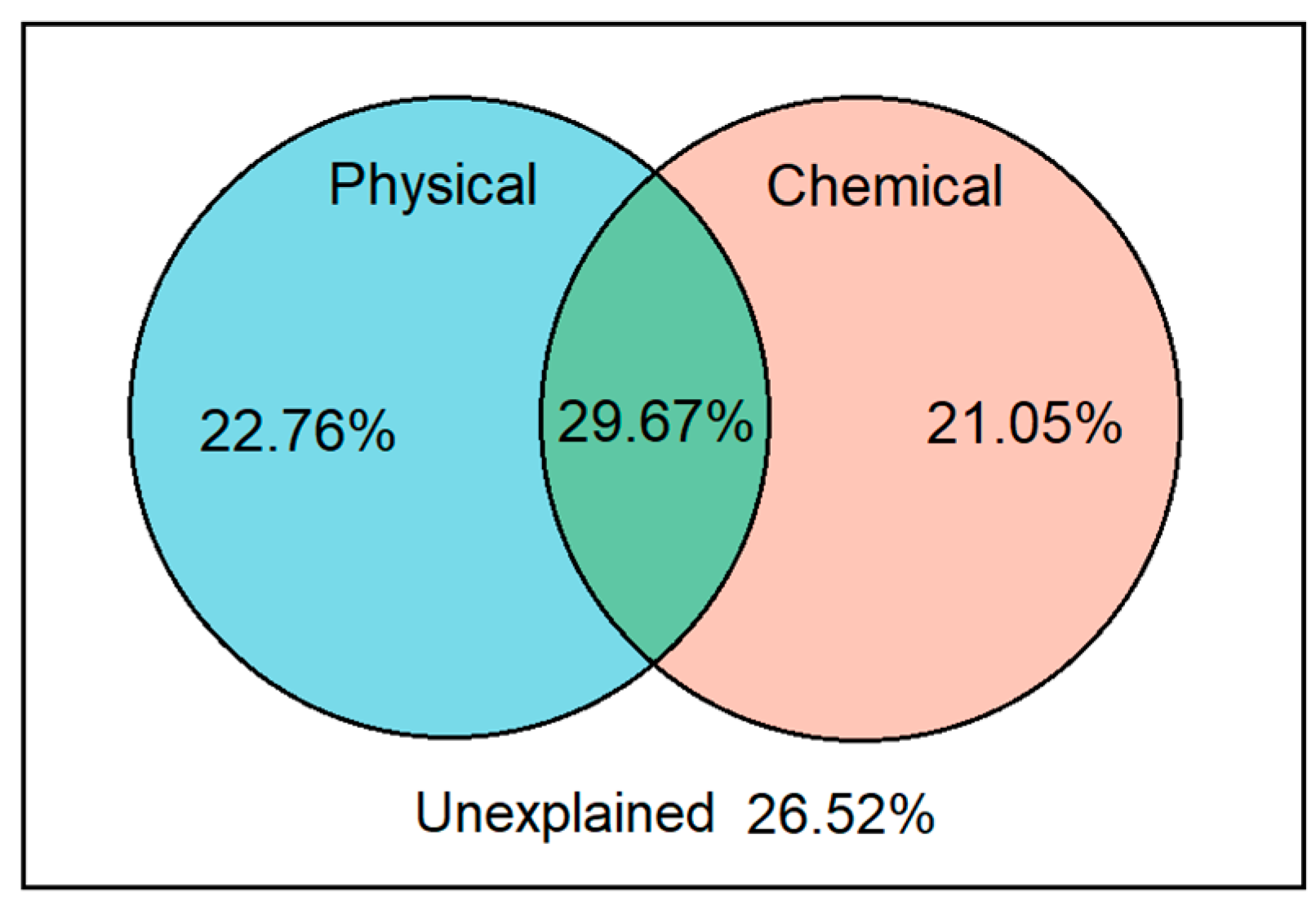
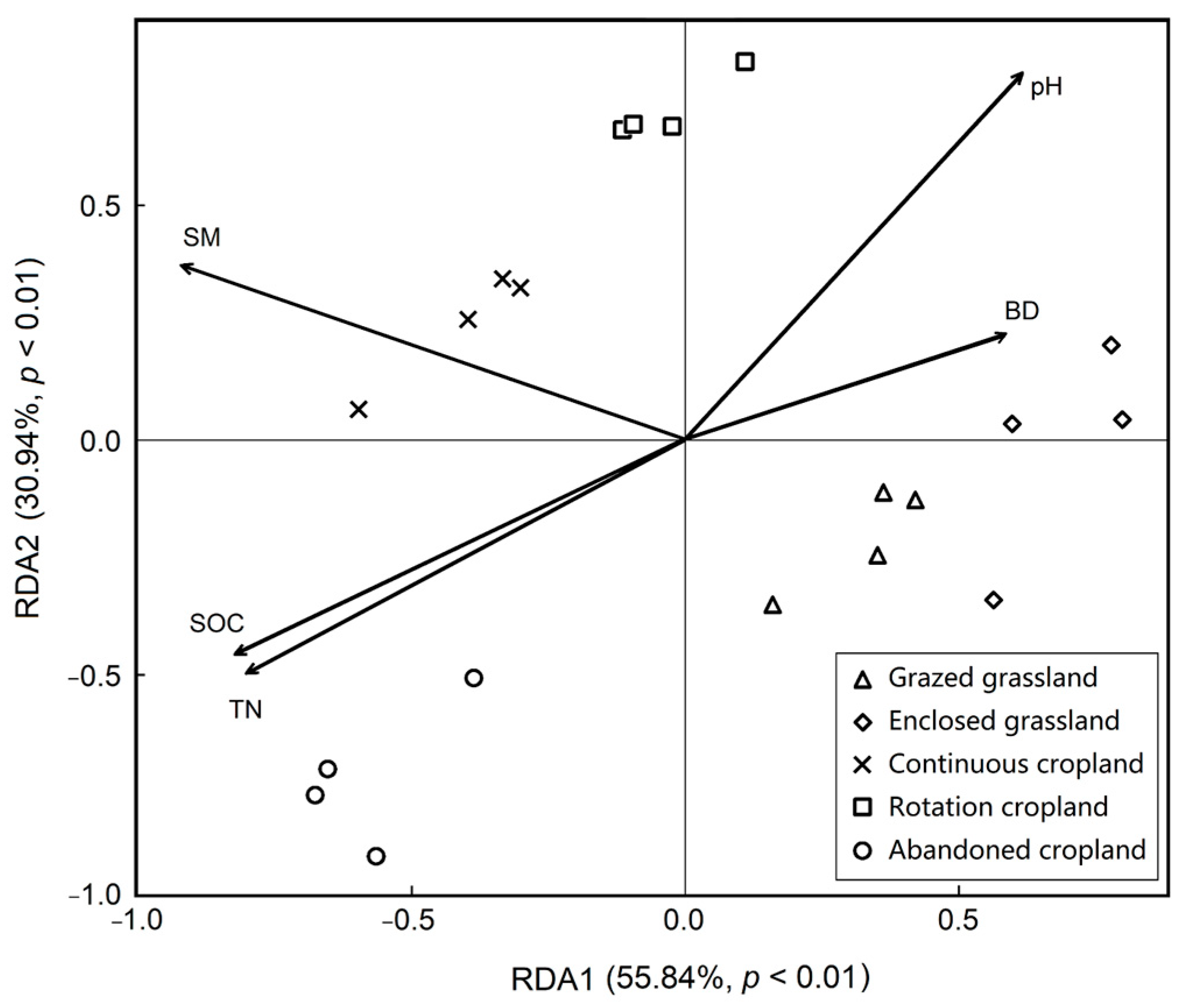
| Land Uses | Observed Species | ACE Index | Chao1 Index | Shannon Index | Simpson Index (×1000) |
|---|---|---|---|---|---|
| Grazed grassland | 4340 ± 75 a | 5110 ± 89 a | 4983 ± 84 a | 9.79 ± 0.05 ab | 995.5 ± 0.3 ab |
| Enclosed grassland | 4359 ± 54 a | 5097 ± 52 a | 4982 ± 50 a | 9.84 ± 0.04 a | 995.8 ± 0.3 a |
| Continuous cropland | 4180 ± 29 ab | 4879 ± 28 a | 4779 ± 23 a | 9.67 ± 0.03 b | 993.5 ± 0.5 b |
| Rotation cropland | 4321 ± 99 ab | 5168 ± 209 a | 5079 ± 214 a | 9.72 ± 0.05 ab | 993.8 ± 0.6 ab |
| Abandoned cropland | 4146 ± 38 b | 4880 ± 50 a | 4769 ± 48 a | 9.43 ± 0.03 c | 989.0 ± 1.3 c |
| Grazed Grassland | Enclosed Grassland | Continuous Cropland | Rotation Cropland | Abandoned Cropland | |
|---|---|---|---|---|---|
| Grazed grassland | - | ||||
| Enclosed grassland | 0.28 ** | - | |||
| Continuous cropland | 0.75 ** | 0.98 ** | - | ||
| Rotation cropland | 0.79 ** | 0.86 ** | 0.49 ** | - | |
| Abandoned cropland | 0.87 ** | 0.98 ** | 0.71 ** | 0.96 ** | - |
| Land Uses | SOC (%) | TN (%) | pH | BD (g cm−3) | SM (%) |
|---|---|---|---|---|---|
| Grazed grassland | 7.0 ± 0.2 b | 0.80 ± 0.02 a | 7.97 ± 0.04 c | 0.83 ± 0.01 c | 23.6 ± 0.8 b |
| Enclosed grassland | 7.7 ± 0.2 a | 0.87 ± 0.03 a | 8.10 ± 0.02 c | 0.71 ± 0.03 d | 29.2 ± 1.1 a |
| Continuous cropland | 3.7 ± 0.1 c | 0.40 ± 0.02 b | 8.36 ± 0.04 b | 0.86 ± 0.01 c | 15.0 ± 0.5 d |
| Rotation cropland | 3.1 ± 0.2 d | 0.26 ± 0.02 c | 8.47 ± 0.02 b | 1.20 ± 0.02 a | 17.5 ± 0.4 c |
| Abandoned cropland | 2.5 ± 0.0 e | 0.20 ± 0.01 c | 8.71 ± 0.12 a | 1.06 ± 0.02 b | 24.9 ± 0.4 b |
Disclaimer/Publisher’s Note: The statements, opinions and data contained in all publications are solely those of the individual author(s) and contributor(s) and not of MDPI and/or the editor(s). MDPI and/or the editor(s) disclaim responsibility for any injury to people or property resulting from any ideas, methods, instructions or products referred to in the content. |
© 2023 by the authors. Licensee MDPI, Basel, Switzerland. This article is an open access article distributed under the terms and conditions of the Creative Commons Attribution (CC BY) license (https://creativecommons.org/licenses/by/4.0/).
Share and Cite
Huang, X.; Shi, J.; Sun, W.; Sun, C.; Shen, X. Cultivation in an Alpine Region: Implications for Soil Bacteria. Agronomy 2023, 13, 296. https://doi.org/10.3390/agronomy13020296
Huang X, Shi J, Sun W, Sun C, Shen X. Cultivation in an Alpine Region: Implications for Soil Bacteria. Agronomy. 2023; 13(2):296. https://doi.org/10.3390/agronomy13020296
Chicago/Turabian StyleHuang, Xiaomin, Jingtao Shi, Wenyuan Sun, Chengming Sun, and Xinping Shen. 2023. "Cultivation in an Alpine Region: Implications for Soil Bacteria" Agronomy 13, no. 2: 296. https://doi.org/10.3390/agronomy13020296
APA StyleHuang, X., Shi, J., Sun, W., Sun, C., & Shen, X. (2023). Cultivation in an Alpine Region: Implications for Soil Bacteria. Agronomy, 13(2), 296. https://doi.org/10.3390/agronomy13020296






